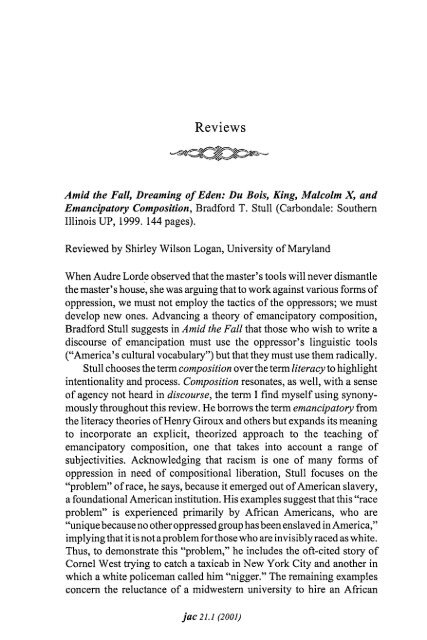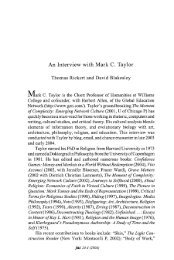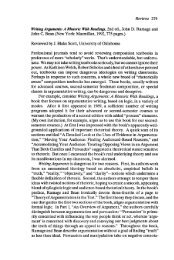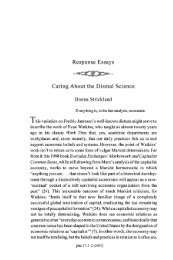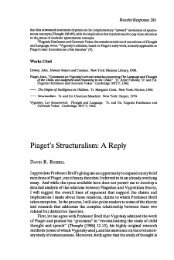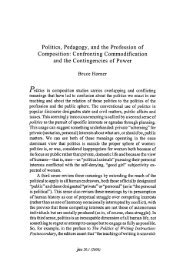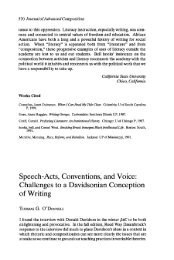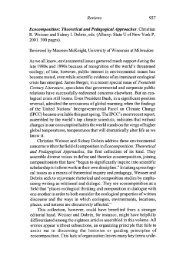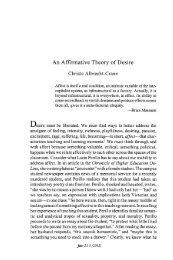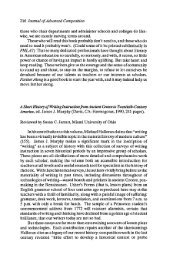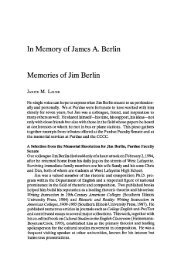Reviews - JAC Online
Reviews - JAC Online
Reviews - JAC Online
You also want an ePaper? Increase the reach of your titles
YUMPU automatically turns print PDFs into web optimized ePapers that Google loves.
<strong>Reviews</strong><br />
Amid the Fall, Dreaming of Eden: Du Bois, King, Malcolm X, and<br />
Emancipatory Composition, Bradford T. Stull (Carbondale: Southern<br />
Illinois UP, 1999. 144 pages).<br />
Reviewed by Shirley Wilson Logan, University of Maryland<br />
When Audre Lorde observed that the master's tools will never dismantle<br />
the master's house, she was arguing that to work against various forms of<br />
oppression, we must not employ the tactics of the oppressors; we must<br />
develop new ones. Advancing a theory of emancipatory composition,<br />
Bradford Stull suggests in Amid the Fall that those who wish to write a<br />
discourse of emancipation must use the oppressor's linguistic tools<br />
("America's cultural vocabulary") but that they must use them radically.<br />
Stull chooses the term composition over the term literacy to highlight<br />
intentionality and process. Composition resonates, as well, with a sense<br />
of agency not heard in discourse, the term I find myself using synonymously<br />
throughout this review. He borrows the term emancipatory from<br />
the literacy theories of Henry Giroux and others but expands its meaning<br />
to incorporate an explicit, theorized approach to the teaching of<br />
emancipatory composition, one that takes into account a range of<br />
subjectivities. Acknowledging that racism is one of many forms of<br />
oppression in need of compositional liberation, Stull focuses on the<br />
"problem" of race, he says, because it emerged out of American slavery,<br />
a foundational American institution. His examples suggest that this "race<br />
problem" is experienced primarily by African Americans, who are<br />
"unique because no other oppressed group has been enslaved in America,"<br />
implying that it is not a problem for those who are invisibly raced as white.<br />
Thus, to demonstrate this "problem," he includes the oft-cited story of<br />
Cornel West trying to catch a taxicab in New York City and another in<br />
which a white policeman called him "nigger." The remaining examples<br />
concern the reluctance of a midwestern university to hire an African<br />
jac 21.1 (2001)
202 jac<br />
American as chancellor; differences in the topics of conversation between<br />
residents of the University of Chicago's Hyde Park community and the<br />
residents of Chicago's south side; and racist jokes told in Malcolm X's<br />
history class. Granted, these examples are meant to be representative of<br />
a larger problem, but I could not help wishing that Stull had provided<br />
salient examples of racism's systemic and ongoing damage to ordinary<br />
black people rather than focusing on the plights of two middle-class black<br />
men, Cornel West and a college chancellor. Or maybe the difficulty is that<br />
examples need to be provided in the first place.<br />
The author studies the emancipatory compositions of W.E.B. Du<br />
Bois, Martin Luther King, Jr. and Malcolm X because he believes them<br />
to be "among the most important rhetoricians of the twentieth century"<br />
and because all three influenced the civil rights, anti-war, and separatist<br />
social movements through their contributions to the discourse on these<br />
subjects. It would be difficult to argue with these choices, given the<br />
"twentieth century" qualifier; still, it is hard to think of emancipatory<br />
compositions with respect to race in America without at least a footnote<br />
reference to such nineteenth-century intellectuals as Frederick Douglass<br />
on abolition and human rights or Ida B. Wells on anti-lynching and<br />
suffrage.<br />
Stull identifies fourtheo-political tropes intheserhetors' emancipatory<br />
compositions: the Fall, the Orient, Africa, and Eden. Alluding on one<br />
level to the biblical fall of Adam and Eve, the trope of the Fall also<br />
suggests various manifestations of societal evils. To demonstrate the<br />
prevalence of this trope in the American context, Stull draws examples<br />
from theologian Reinhold Niebuhr, John Milton's Paradise Lost, poet<br />
Mary Fell, popular culture, and finally Kenneth Burke. From Burke, he<br />
derives three subcategories-"Babel," "division of property," and "violence"-upon<br />
which to develop his analysis. Exploring the theme of<br />
Babel in Malcolm X's autobiography and speeches, Stull points to the<br />
writer's struggle to increase his own linguistic storehouse and his recognition<br />
that difference resides in world views as well as language. Stull<br />
suggests that Malcolm X appropriated Standard American English (SAE)<br />
in order to overcome the limitations of Babel and speak to dominant<br />
culture. For support, he cites Malcolm X's oft-quoted statement, "You<br />
have to be able to speak a man's language in order to make him get the<br />
point." Limiting his analysis ofDu Bois to his writings in the Crisis, the<br />
organ of the NAACP, Stull finds allusion to Babel in Du Bois' discussion<br />
of meanings of the word negro, stating that he "appeals to the American<br />
rhetorical heritage." Perhaps Stull might have complicated the assump-
<strong>Reviews</strong> 203<br />
tions inherent in a phrase that reifies such a heritage. Who can claim this<br />
heritage and who established it? Stull does later observe that Du Bois steps<br />
outside of this heritage in order to question it, but the solution seems to be<br />
to choose another language: French. King, according to Stull, finds a<br />
solution to Babel in the Judeo-Christian tradition and in the belief that this<br />
tradition contains within it elements of a universal language reaching a<br />
broad audience. Stull observes that all three writers cite economic<br />
deprivation and violence as further evidence offallen America. Given that<br />
most African peoples were brought to America as property, it is not<br />
surprising that "division of property " emerges as a trope of emancipatory<br />
composition. Stull reiterates some of the economic inequities these<br />
writers' works address, adding examples from Spike Lee's movie Do the<br />
Right Thing perhaps to convince contemporary readers that such inequities<br />
still exist.<br />
The second emancipatory trope, the Orient, manifests itself in the<br />
ways in which Du Bois, King, and Malcolm X remind their audiences of<br />
the parallel and frequently intersecting incidents of oppression of African<br />
and Asian peoples; all three writers acknowledge a close kinship of<br />
oppression among peoples of color worldwide. Stull defends his use of the<br />
term Orient-with its concurrent images of alien other, wise person, and<br />
backward people-as being particularly comprehensive. He asserts that<br />
Orient can include Egypt as well as Japan and can serve to remind us of<br />
how the West reductively composed this vast territory. Having myself<br />
been trained out of using the descriptor Oriental, it was disconcerting to<br />
find it here. Using a phrase such as "Eastern culture(s)" may have been a<br />
more effective way to remind readers of this tendency, especially since,<br />
at least in the examples provided, the three writers never use Orient and<br />
seem always to refer to specific geographical locations-Japan, China,<br />
India (Calcutta and Bombay), and Vietnam-even ifstereotypically. As<br />
in his earlier demonstration of a racist America, Stull provides more than<br />
enough examples of stereotypical perceptions of the Orient, including<br />
examples from the movies The Next Karate Kid and City of Hope, Isabel<br />
Allende's novel The Infinite Plan, and E.D. Hirsch's Cultural Literacy.<br />
One wonders whether, by offering so much wide-ranging evidence that<br />
Eastern culture is misunderstood, the author imagines a fairly naive<br />
audience.<br />
Stull seems particularly eager to account for his inclusion of Africa<br />
as a trope of emancipatory rhetoric: "They [extremists] might wonder<br />
why I, who profess parochially American inclinations, who is a conservative,<br />
would include this term, would demand that Americans who
204 jac<br />
would be literate know Africa and its web of associations. Africa, after all,<br />
necessarily leads to a condemnation of the American republic." Unless<br />
the point of emancipatory composition is to make those to whom it<br />
appeals feel comfortable, eliciting such a reaction would seem to be all the<br />
more reason why Africa should be included. Later in this chapter, Stull<br />
makes the strong point that this national vocabulary isa site of contention,<br />
in opposition to E.D. Hirsch's assertion that it is rather "an instrument of<br />
communication among diverse cultures." This is a point well worth<br />
remembering especially at places in the text where such terms as "American<br />
culture" are used unproblematically. In order to illustrate that Africa<br />
has dual images in America (monstrous/noble and suffering), the author<br />
gives the example of a student enrolled in a writing class who, in spite of<br />
poor performance, received the admiration of his peers because he was<br />
studying to become a Muslim and wore an African icon around his neck<br />
("publicly composing Africa on his own body"). The author sees this<br />
dress and behavior as a way of demonizing America and sanctifying<br />
Africa. It may in fact represent the student's attempt to construct a positive<br />
self-image, or, as Stull states, it could merely be an "aestheticized piece<br />
ofjewelry"-or a bit of both. At any rate, Stull observes that given the<br />
student's gesture, this classroom might have served as a site of discussion<br />
of emancipatory composition. Fully elaborated examples from the film<br />
Legends of the Fall are offered as evidence of the various ways in which<br />
America composes a savage Africa. Stull sees Spike Lee's film School<br />
Daze as another example of this opposition, with the fraternity men on one<br />
side and the "young radicals" who protest South African apartheid on the<br />
other. My sense is that the film ismore complicated in that the frat brothers<br />
probably also oppose apartheid and that the young radicals in African<br />
clothing also desire financial success. The movie has less to do with Africa<br />
than with ways of surviving in America. Stull also notes that in their<br />
compositions of Africa, the three writers seem to appropriate the cause of<br />
a suffering Africa only as a means of pleading for suffering African<br />
America, rather than out of concern for African liberation. He suggests<br />
that Malcolm X tries to offset in his later speeches a prior belief in the<br />
"myth" that blacks were the first humans from whom all other peoples<br />
were derived. In view of the fact that for many, then and now, this is not<br />
considered myth, perhaps the author could have qualified this characterization.<br />
Even Du Bois, later quoted as claiming Ethiopia the "All-mother<br />
of men," would himself seem to subscribe to this belief, one the author<br />
characterizes as a "radical vision."<br />
Malcolm X's speech "After the Bombing" provides ample evidence
<strong>Reviews</strong> 205<br />
of this emancipatory trope. In it, he highlights the ways in which negative<br />
images of Africa have affected African Americans, and in another speech<br />
he composes an Africa that Americans can model emancipation after.<br />
Stull observes that King viewed blacks in America as having greater<br />
economic potential and that he concentrated, along with Du Bois, on only<br />
portraying Africa's positive images. Du Bois' pan-Africanist writings are<br />
invoked to remind the reader that Du Bois' Africa would serve as a center<br />
for worldwide negotiations.<br />
Stull's chapter on Eden is his most astute. Eden, the last of the<br />
carefully ordered tropes, marks desire. All three writers describe Eden as<br />
a nonexistent ideal. Stull suggests that the socioeconomic privilege ofDu<br />
Bois and King resulted in a more positive perspective from which to<br />
envision Eden than did Malcolm X' s disruptive life experiences. Malcolm<br />
X's Eden took shape as a separatist black Africa of economic and political<br />
empowerment. In the pages of the Crisis, Du Bois draws on his experience<br />
of parts of America to compose his Eden-Oberlin, Ohio, Seattle, and the<br />
American Northwest-but he ultimately argues for the "Edenic potential"<br />
of Africa. King, however, never viewed Africa as an Edenic alternative.<br />
In his "I Have a Dream" speech, for example, he envisions an Eden<br />
firmly rooted in American principles but growing beyond its walls and out<br />
into an unknown paradise resonating with images of the second coming.<br />
In short, Stull outlines these three writers' differing responses to an<br />
oppressive America and in the process captures some of the essential<br />
differences in their worldviews, linking those differences to biography.<br />
Stull's final chapter reiterates the point made in the first-that<br />
emancipatory composition must be crafted in the "familiar language of<br />
the community only to transform it." Thus, he positions his argument<br />
between the political right of William Bennett and E.D. Hirsch and the<br />
political left of Ray Browne, Henry Giroux, Arthur Neal, Barbara Hemstein<br />
Smith, and others. According to Stull, the Right would frown upon this<br />
discourse because it is a discourse that condemns America as racist and<br />
looks to Africa for solutions; the Left would reject the notion of a common<br />
set of theo-political tropes as an attempt to standardize a nonexistent<br />
common cultural knowledge. Stull counters that we both receive and<br />
shape literacy and culture and that even those who reject the notion of<br />
cultural literacy allude to common knowledge in their writing. So here at<br />
the end, Stull pulls us back into the cultural literacy debate-or maybe we<br />
were in the midst of it all the time. The issue here, it seems, is not that we<br />
allude to things "out there" in the construct called "culture" but that we<br />
recognize those referents, along with their freighted meanings, and know
206 jac<br />
them for the ways in which they have promoted the goals of oppression.<br />
If the Fall, the Orient, Africa, and Eden are the theo-political tropes of<br />
emancipatory composition, we all helped to make them so. Now, as Audre<br />
Lorde understood, this is a tricky rhetorical move: to appropriate the<br />
oppressor's tools-which are also our tools-ever mindful of the work<br />
they have done in the past, and apply them to the task of emancipation. For<br />
Stull, to accomplish this is to "Be conservative. Be extreme. Be radical,"<br />
all at the same time.<br />
Although Stull's purpose was not to write a history of black intellectual<br />
thought, perhaps more context could have been included here. To<br />
what extent were these texts in conversation with other contemporaneous<br />
emancipatory discourses? How might these three authors' writings have<br />
been influenced by those of intellectuals like Frederick Douglass, Martin<br />
Delany, Booker T. Washington, Alexander Crummell, James Baldwin,<br />
Paul Robeson, or Ralph Ellison? There is also a troubling absence of<br />
discussion about the contributions of women, either as primary or<br />
secondary sources. Women like Anna Julia Cooper, Ida B. Wells, Mary<br />
Church Terrell, Zora Neale Hurston, Audre Lorde, and Toni Morrison<br />
have had much to say about the challenges of emancipation. Such<br />
coverage may be too much to expect of one volume, but, given the<br />
assumed naivete of the readers (as evidenced by the kinds of examples<br />
offered), I worry that many will come away thinking that these were three<br />
exceptional rather than representative black thinkers. But perhaps such<br />
inclusion could be the challenge of subsequent projects.<br />
Stull has produced valuable scholarship that engages in a close<br />
reading of the work these rhetors perform through their compositions. It<br />
says to readers, "Pay attention to these writers for what they have to say<br />
rather than because they are marked in a certain way." It is one of the few<br />
rhetorical studies of Du Bois' writing in the Crisis, all of which were<br />
produced after the 1903publication of his influential Souls of Black Folk.<br />
It considers less well-known texts of Malcolm X, and it even offers new<br />
ways to approach Martin Luther King, Jr.'s "I Have a Dream" speech by<br />
considering it in relation to some of his other writings. It also represents<br />
an important contribution to rhetorical theory in that it has implications<br />
for understanding the kinds of rhetorical strategies available as means of<br />
persuasion for those responding to a common exigence, even when those<br />
rhetors respond under differing circumstances. It implies a genre called<br />
"emancipatory composition" with its own set of topoi. Further, its tightly<br />
constructed organization models a certain kind of rhetorical analysis.<br />
Students of composition theory and pedagogy will appreciate itsjargon-
<strong>Reviews</strong> 207<br />
free description of the composing strategies of three intellectuals writing<br />
from the margins. The examples of the four theo-political tropes drawn<br />
from popular culture make the theory more accessible and point to<br />
practices that can be imported into the writing classroom. For these and<br />
other reasons, I intend to use it as a recommended text next spring in a<br />
seminar in applied rhetoric, and I will certainly use it the next time I teach<br />
composition theory. It points us in the right direction as we continue our<br />
efforts to understand how effective compositions use the master's tools to<br />
do their work. Stull and Audre Lorde may, in fact, both be right.<br />
Traces of a Stream: Literacy and Social Change Among African<br />
American Women,Jacqueline Jones Royster (Pittsburgh: U of Pittsburgh<br />
P, 2000.352 pages).<br />
Reviewed by Juanita Rodgers Comfort, Old Dominion University<br />
Tracesof a Streamis an exceptional starting point for scholars who wish<br />
to examine the literate practices of African American women. Not only is<br />
it a striking effort to redefine a theory and methodology for engaging<br />
rhetoric as a cultural study, it is also a valuable attempt to reclaim the<br />
intellectual traditions of a group that historically has not been regarded by<br />
mainstream critics as intellectually or socially significant. Jacqueline<br />
Royster explains that her book's theme emerged from the discovery that<br />
African American women have experienced a long history of literacy and<br />
intellectualism, extending back beyond their presence in this country to<br />
their ancestral roots in West Africa. Speaking of racism, sexism, and other<br />
forms of oppression that have relegated these women to the margins of<br />
society, she writes, "Periodically ... these women have managed to break<br />
out from containments seeking to enclose them. Periodically, their talents<br />
have flowed past the barriers, reconstituted themselves, and become<br />
noticeable as 'traces of a stream. '"<br />
She divides her study into three interwoven parts which examine<br />
rhetorical, historical, and ideological perspectives on the literate practices<br />
of a group that she calls elite nineteenth-century African American<br />
women, products of "an era during which the shift in educational<br />
opportunity after the Civil War gave rise for the first time to the<br />
development of a cadre ofwell-educated women." She uses the descriptor<br />
"elite" not merely to highlight socioeconomic privilege but also-per-


